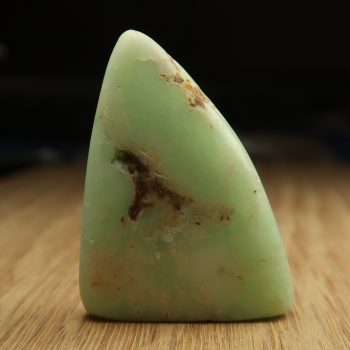Chrysoprase
Chrysoprase is a gemstone variety of Chalcedony, given a gorgeous apple green colouration by the inclusion of Nickel.
Chrysoprase is often used for jewellery making, or as a decorative object. It is found around the world, in various qualities and shades of green.
Showing all 2 results
Appearance, Uses and History
Chrysoprase is one of the most valuable variants of Chalcedony, a cryptocrystalline variety of Quartz.
It is tremendously popular in Asia, possibly due to the popularity of Jade and Jadeite – both green stones.
The green of Chrysoprase is generally quite ‘flat’, solid colouration with few markings, tones, and inclusions. Some pieces do have a green-yellow or green-blue tone but these are less common and not often used.
Locales
Locales for Chrysoprase include Australia, Brazil, Germany, Kazakhstan, Madagascar, Russia, and the USA – with the Australian pieces typically considered the highest quality.
Mineralogy
Sometimes dyed to improve colour.
Hazards and Warnings
Chrysoprase contains Nickel, which is a common allergen, usually by skin contact.
Almost all rocks, minerals (and, frankly, almost all other substances on earth) can produce toxic dust when cutting, which can cause serious respiratory conditions including silicosis.
When cutting or polishing rocks, minerals, shells, etc, all work should be done wet to minimise the dust, and a suitable respirator or extraction system should be used.
Translations
Arabic:
- کریزوپراز
Hindi:
Portuguese:
- crisoprase
Bengali:
Indonesian:
Punjabi:
- ਕ੍ਰਾਈਸੋਪਰੇਸ
English:
Italian:
Russian:
- хризопраз
French:
Japanese:
- クリソプレーズ
Spanish:
- crisoprasa
German:
- Chrysopras
Korean:
- 크리 소프 라세
Thai:
Gujurati:
Mandarin and Traditional Chinese:
- 金绿素酶
Urdu:
- کریسوپراز
- کریزوپراز


